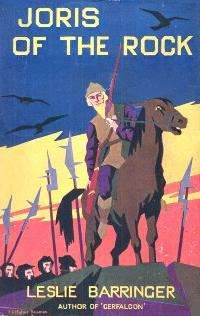Joris of the Rock
 First edition dust cover | |
| Author | Leslie Barringer |
|---|---|
| Country | United Kingdom |
| Language | English |
| Series | Neustrian Cycle |
| Genre | Historical fantasy novel |
| Publisher | William Heinemann |
Publication date | 1928 |
| Media type | Print (Hardback) |
| Pages | 325 pp |
| Preceded by | Gerfalcon (1927) |
| Followed by | Shy Leopardess (1948) |
Joris of the Rock is a fantasy novel by Leslie Barringer, the second book in his three volume Neustrian Cycle. It is set around the fourteenth century in an alternate medieval France called Neustria (historically an early division of the Frankish kingdom). The book was first published in the United Kingdom by Heinemann in 1928; an American edition followed from Doubleday in 1929. Its significance was recognized by its republication by the Newcastle Publishing Company as the ninth volume of the celebrated Newcastle Forgotten Fantasy Library series in September, 1976. The Newcastle edition was reprinted by Borgo Press in 1980 and 2010.[1]
The publisher's blurb for the 1928 edition reads:
"Mediaeval outlaws were not as a rule good neighbours, and Joris is no exception. Believing himself to be one of the men for whom this world was made, he challenges Church and State, loves and waits for the witch, Red Anne, fights a fiend by the Singing Stones, finds a kingdom in his gift, and meets at length the youth who is his son. The interwoven lives of Joris and Juhel afford a texture now harsh now delicate, shadowed by grimmest irony, yet lit with fires of loyalty and faith. The action of the story, beginning before the action of Gerfalcon, includes and overpasses the time of the latter; neither tale is needed for the enjoyment of the other, but many readers will welcome a new encounter with Raoul of Ger and his friends in the days of their prosperity."
Chapter headings of the 1928 edition:
- The way of Joris of the Rock.
- The tower of Ath.
- Herodias at Hastain.
- The patience of Joris of the Rock.
- Diana in the forest.
- Saint-Eloy-over-Hardonek.
- Gramberge and the Singing Stones.
- Colloquy at Belsaunt.
- The spires of Hautarroy.
- The glory of Joris of the Rock.
- The causeway at Markmont.
- Pont-de-Foy.
- The beating of the high hills.
- The son of Joris of the Rock.
Reception
A review in the Manchester Guardian characterized Joris of the Rock as a "period novel" in contrast to a historical one, and called it "a robust, a teaming book," "a tensely plotted tale which marches at swinging pace to bear witness to its author's rich inventiveness."[2]
Notes
- ↑ Joris of the Rock title listing at the Internet Speculative Fiction Database
- ↑ B., H. "Books of the Day. New Novels. The Period Novel. Joris of the Rock." in The Manchester Guardian, October 19, 1928, page 7.
References
- Reginald, Robert. Xenograffiti: essays on fantastic literature. (2005 second edition), I. O. Evans Studies in the Philosophy and Criticism of Literature, number 33 Borgo Press ISSN 0271-9061
- De Camp, L. Sprague. Literary Swordsmen and Sorcerers: the Makers of Heroic Fantasy. Arkham House, 1976.
- Carter, Lin. Imaginary Worlds: the Art of Fantasy. Ballantine Books, 1973.